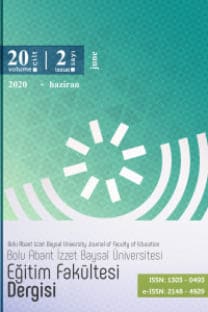Effectiveness of Computers in the Classroom and Teachers' Training needs for Successful Integration of Computers in Education
Effectiveness of Computers in the Classroom and Teachers' Training needs for Successful Integration of Computers in Education
___
- Albion, P. R. & Ertmer, P. A. (2002). Beyond the Foundations: The Role of Vision and Belief in Teachers’ Preparation for Integration of Technology. Tech-Trends for Leaders in Education and Training, 46(5), 34-38.
- Anderson, R. E., Welch, W. W. & Harris, L. J. (1984). Inequities in Opportunities for Computer Literacy. The computing Teacher, 11(8), 10-12.
- Andris, M. E. (1996). An Apple for the Teacher: Computers and Works in Elementary Schools. California: Crowin Press.
- Becker, H. J. (1992). Top-Down Versus Grass Roots Decision-Making about Computer Acquisition and Use in American Schools. (ERIC Document Reproduction Service No. ED356769).
- Becker, H. J. (1994). How Exemplary Computer-Using Teachers Differ From Other Teachers: Implications for Realizing the Potential of Computers in Schools. Journal of Research on Computing in Education, 26(3), 291-321.
- Branson, R. K. (1998). Teaching-Centered Schooling Has Reached Its Upper Limit: It Does Not Get Any Better Than This. Current Directions in Psychological Science, 7(4), 126-135.
- Brauer, R. (1995). The Internet as School, or Welcome to Our MUD Room. Technos, 4(3), 14-21.
- Cormack, V. M. (1995). Training Pre-Service Teachers in Applying Computer Technology to Lesson Planning as a Component of the Elementary School Methods
- Curriculum. (ERIC Document Reproduction Service No. ED382190). D'Ignazio, F. (1995). The Technology Administrator's Field of Dreams. Dream Number 2: Technology as a Solution. Learning and Leading with Technology, 23(3), 43-44.
- Dunn, S. & Ridgway, J. (1991). Computer Use During Primary School Teaching Practice. Journal of Computer Assisted Learning, 7(1), 7-17.
- Dupagne, M. & Krendl, K. A. (1992). Teachers’ Attitude Toward Computers: A Review of the Literature. Journal of Research on Computing in Education, 24(3), 420-429.
- Flake, J. L. (1995). Elementary and Middle School Mathematics Learning in a Technology Age. Tallahassee: Florida State University.
- Forcheri, P. & Molfino, M. T. (1986). Teacher Training in Computers and Education: A Two-Year Experience. Computer Education, 10(1), 137-143.
- Gilmore, A. M. (1995). Turning Teachers on to Computers: Evaluation of a Teacher Development Program. Journal of Research on Computing in Education, 27(3), 251-169.
- Guffey, S. J. (1998). Curriculum and Technology: Integration Through Modeling. (ERIC Document Reproduction Service No. ED418075).
- Hardy, J. V. (1998). Teacher Attitudes Toward and Knowledge of Computer Technology. Computers in the Schools, 14(3), 119-136.
- Kitabchi, G. (1987). Evaluation of the Apple Classroom Tomorrow. (ERIC Document Reproduction Service No. ED295600).
- Knupfer N. N. (1995). Teachers and Educational Computing: Changing Roles and Changing Pedagogy. In R. Muffoletto & N. N. Knupfer (ed.) Computers in Education: Social, Political, and Historical Perspectives (163-180). New Jersey: Hampton Press.
- Kulik, J. & Kulik, C. C. (1987). Computer-Based instruction: What 2000 Evaluations Say. (ERIC Document Reproduction Service No. ED285521).
- Kulik, J. A. (1994). Meta-Analytic Studies of Findings on Computer Based Instruction. In E. L. Baker and H. F. O’Neil (ed.). Technology Assessment in Education and Training (9-33). New Jersey: Lawrence Erlbaum.
- Mager, R. F. & Pipe, P. (1997). Analyzing Performance Problems. Atlanta: CEP.
- Mandell, S., Sorge, D.H. & Russell, J.D. (2002). Tips for Technology Integration. Tech-Trends for Leaders in Education and Training, 46(5), 39-43.
- McNamara, S. & Pedigo, M. L. (1995). Development of an Individualized Computer Training Model for Classroom Teachers. (ERIC Document Reproduction Service No. ED384596).
- Pugalee, D. K. (1998). The Study of the Impact of Teacher Training in Using Internet Resources for Mathematics and Science Instruction. Journal of Research on Computing in Education, 31(1), 78-88.
- Rothwell, W. J., & Kazanas, H. C. (1998). Mastering the Instructional Design Process: A systematic Approach. San Francisco: Jossey-Bass Inc.
- Schofield, J. W. (1995). Computers and Classroom Culture. New York: Cambridge University Press.
- Sheingold, K. & Hadley, M. (1990). Accomplished Teachers: Integrating Computers into Classroom Practice. Center for Technology in Education: Bank Street College of Education.
- Siegel, J. (1995). The State of Teacher Training. Electronic Learning, 14(8), 43-50.
- Sivin-Kachala, J. (1998). Report on the Effectiveness of Technology in Schools, 1990-1997. Software Publisher Association.
- Tally, B. (1995). Developmental Training. Electronic Learning, 15(1), 14-15.
- Walters, J. T. (1992). Technology in the Curriculum: The Inclusion Solution. (ERIC Document Reproduction Service No. ED350281).
- Webb, N. M. (1989). Peer Interaction and Learning in Small Groups. International Journal of Educational Research, 13(1), 21-39.
- Wetzel, K., Zambo, R. & Buss, R. (1996). Innovations in Integrating Technology into Student Teaching Experience. Journal of Research on Computing in Education, 29(2), 196-214.
- Wild, M. (1996). Technology Refusal: Rationalizing the Failure of Student and Beginning Teachers to Use Computers. British Journal of Educational Technology, 27(2), 134-143.
- Willis, J. E. (1994). Technology and Teacher Education Annual. (ERIC Document Reproduction Service No. ED392388).
- ISSN: 1303-0493
- Yayın Aralığı: 4
- Başlangıç: 2000
- Yayıncı: Abant İzzet Baysal Üniversitesi Eğitim Fakültesi
Eleştirel Düşünme Öğretimi ve Bloom'un Aşamalı Sınıflaması
Sosyal Becerileri Değerlendirme Ölçeğinin (7-12 Yaş) Geçerlik ve Güvenirlik Çalışması
Gönül AKÇAMETE, Hasan AVCIOĞLU
Ortaöğretim Okullarında Öğretmen Morali
A Research on the Satisfaction Feelings of Teacher Candidates
Portfolyo Değerlendirme: Tanımı, Özellikleri, Uygulanması, Üstünlükleri ve Sınırlılıkları
